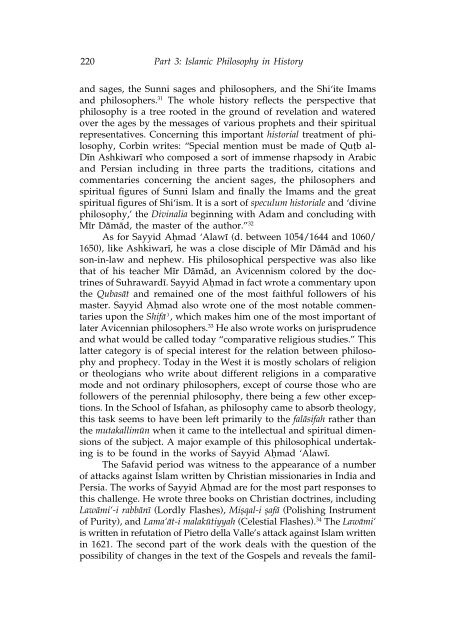Islamic Philosophy from Its Origin to the Present: Philosophy in the ...
Islamic Philosophy from Its Origin to the Present: Philosophy in the ...
Islamic Philosophy from Its Origin to the Present: Philosophy in the ...
You also want an ePaper? Increase the reach of your titles
YUMPU automatically turns print PDFs into web optimized ePapers that Google loves.
220 Part 3: <strong>Islamic</strong> <strong>Philosophy</strong> <strong>in</strong> His<strong>to</strong>ry<br />
and sages, <strong>the</strong> Sunni sages and philosophers, and <strong>the</strong> Shi‘ite Imams<br />
and philosophers. 31 The whole his<strong>to</strong>ry reflects <strong>the</strong> perspective that<br />
philosophy is a tree rooted <strong>in</strong> <strong>the</strong> ground of revelation and watered<br />
over <strong>the</strong> ages by <strong>the</strong> messages of various prophets and <strong>the</strong>ir spiritual<br />
representatives. Concern<strong>in</strong>g this important his<strong>to</strong>rial treatment of philosophy,<br />
Corb<strong>in</strong> writes: “Special mention must be made of Qu†b al-<br />
D¥n Ashkiwar¥ who composed a sort of immense rhapsody <strong>in</strong> Arabic<br />
and Persian <strong>in</strong>clud<strong>in</strong>g <strong>in</strong> three parts <strong>the</strong> traditions, citations and<br />
commentaries concern<strong>in</strong>g <strong>the</strong> ancient sages, <strong>the</strong> philosophers and<br />
spiritual figures of Sunni Islam and f<strong>in</strong>ally <strong>the</strong> Imams and <strong>the</strong> great<br />
spiritual figures of Shi‘ism. It is a sort of speculum his<strong>to</strong>riale and ‘div<strong>in</strong>e<br />
philosophy,’ <strong>the</strong> Div<strong>in</strong>alia beg<strong>in</strong>n<strong>in</strong>g with Adam and conclud<strong>in</strong>g with<br />
M¥r Dåmåd, <strong>the</strong> master of <strong>the</strong> author.” 32<br />
As for Sayyid A±mad ‘Alaw¥ (d. between 1054/1644 and 1060/<br />
1650), like Ashkiwar¥, he was a close disciple of M¥r Dåmåd and his<br />
son-<strong>in</strong>-law and nephew. His philosophical perspective was also like<br />
that of his teacher M¥r Dåmåd, an Avicennism colored by <strong>the</strong> doctr<strong>in</strong>es<br />
of Suhraward¥. Sayyid A±mad <strong>in</strong> fact wrote a commentary upon<br />
<strong>the</strong> Qubasåt and rema<strong>in</strong>ed one of <strong>the</strong> most faithful followers of his<br />
master. Sayyid A±mad also wrote one of <strong>the</strong> most notable commentaries<br />
upon <strong>the</strong> Shifå˘, which makes him one of <strong>the</strong> most important of<br />
later Avicennian philosophers. 33 He also wrote works on jurisprudence<br />
and what would be called <strong>to</strong>day “comparative religious studies.” This<br />
latter category is of special <strong>in</strong>terest for <strong>the</strong> relation between philosophy<br />
and prophecy. Today <strong>in</strong> <strong>the</strong> West it is mostly scholars of religion<br />
or <strong>the</strong>ologians who write about different religions <strong>in</strong> a comparative<br />
mode and not ord<strong>in</strong>ary philosophers, except of course those who are<br />
followers of <strong>the</strong> perennial philosophy, <strong>the</strong>re be<strong>in</strong>g a few o<strong>the</strong>r exceptions.<br />
In <strong>the</strong> School of Isfahan, as philosophy came <strong>to</strong> absorb <strong>the</strong>ology,<br />
this task seems <strong>to</strong> have been left primarily <strong>to</strong> <strong>the</strong> falåsifah ra<strong>the</strong>r than<br />
<strong>the</strong> mutakallim¶n when it came <strong>to</strong> <strong>the</strong> <strong>in</strong>tellectual and spiritual dimensions<br />
of <strong>the</strong> subject. A major example of this philosophical undertak<strong>in</strong>g<br />
is <strong>to</strong> be found <strong>in</strong> <strong>the</strong> works of Sayyid A±mad ‘Alaw¥.<br />
The Safavid period was witness <strong>to</strong> <strong>the</strong> appearance of a number<br />
of attacks aga<strong>in</strong>st Islam written by Christian missionaries <strong>in</strong> India and<br />
Persia. The works of Sayyid A±mad are for <strong>the</strong> most part responses <strong>to</strong><br />
this challenge. He wrote three books on Christian doctr<strong>in</strong>es, <strong>in</strong>clud<strong>in</strong>g<br />
Lawåmi‘-i rabbån¥ (Lordly Flashes), Miƒqal-i ƒafå (Polish<strong>in</strong>g Instrument<br />
of Purity), and Lama‘åt-i malak¶tiyyah (Celestial Flashes). 34 The Lawåmi‘<br />
is written <strong>in</strong> refutation of Pietro della Valle’s attack aga<strong>in</strong>st Islam written<br />
<strong>in</strong> 1621. The second part of <strong>the</strong> work deals with <strong>the</strong> question of <strong>the</strong><br />
possibility of changes <strong>in</strong> <strong>the</strong> text of <strong>the</strong> Gospels and reveals <strong>the</strong> famil-

















